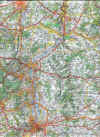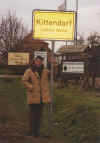

Send
me an email:

marc_kitten@hotmail.com
| |
Origin:
 | In the 16th century, maybe much earlier, The Kütten (or Kütt)
family name appears on the eastern part of the Mosel river, in the border region delimited by Luxemburg, Lorraine, and the
Germanic Palatinate. This region is known like the “country of the three
borders”. This is the origin of the French and Palatinate Kitten families. Strangely,
my French ancestor becomes a "Kitten" at the end of the
18th century, while some of my Palatine cousins only change
during the 19th century. (With other alterations like “Kuth”, "Koeth",
“Koetten”,
“Ketten” and “Kietten”). |
I could rebuild most branches of the family tree, some going back up to about
1600. All of them come
from villages of the Moselle region, located a few kilometers from each others (see
map). The oldest known site is the village of Bous. I hope to be able to link
all the branches together one day...
 |
Many other Kutten and other variations of the name are to be found in
the Rhineland, especially in the Duesseldorf aera, and in Westfalia. They appear
at least in the 16th century. Some of these variations may be
linked to the family: Kuiten, Kuehten, Kuhten, Kuethen, Kuthen, Gutten, Guethen,
Cutten, Cuethen, Kueth, Koetten, Kohten, etc... |
The oldest (and certainly not
related) mention of the name that I know is from "KUTHEN, Khan of
Cumania,
born ab. 1214, died between 1244 and 1305, father of Erzsebet (Elisabeth)
KUTHEN VON BOSNIEN, born ab. 1240, died 1292, married to Stephen V, King of
Hungary.
The numerous Kitten from Westfalia are
probably related to the Kütten families (same phonetic in old German). The
name would have been traced back to the 12th century.
* * *
Etymology
 |
In "Etymologisches Wörterbuch der deutschen Familiennamen" (Prof.
Josef Karlmann Brechenmacher): Kitt/Kütt ÜN zu mhd. Kûte =
Tauber (pigeon). In 1559, Jacob Kytth from Konstanz gets a
blazon that includes a white pigeon. |
 |
Otherwise,
Kutte
" means " frock ", "Kütte" means
"flock, herd", but
"Kütten" means quince (the fruit), like "Quitten". |
 |
Others consider
the Kitten name as a variant
of Kittan, diminutive that corresponds to Christian, like Kitto,
which could be the origin of the Kitt
patronymic (FranceGenWeb). |
From: G. Marterer - Graz. Newsgroups: de.sci.genealogie
 | According to Heinze (1882): |
Kitt- Kut-.... see Chud
Chud-: from the first generation of family names. Signification
unknown
-> Chuderat, Chudpert -> Kaupert; Kaupper; Chudheri -> Kutter;
Kuder; Küder; Kitter, also Kauders.
Diminutives: Küderle, Kiderle(n).
Diminutive from Chud- : Chudo -> Kuth(e); Kaut; Kitt.
with, again, a diminutive: Kittel.
(zu) Chuzo: Ku(h)tz; Kau(t)z; Ku(t)sch; Kuß; Kaus(ch). Kussmann, Küß-,
Kusch-, Keutzen (e.g. in Köln), Kitzel, Küssel, Kissel, Kiesel.
* * * *
Miklosich on "chudu":
Old sloven= bad
* * * *
Gut .... see Godaz
Godaz: from the first generation of family names. Derives from the gothic
"gobs" = "good" -> Gutte; Gut(h)e; Kuthe etc.
 | Medieval etymology |
Morin Kytte Lauman. Name and device. Argent, a unicorn rampant sable and on
a chief azure a plate between an increscent and a decrescent argent.
Found on the LoI as Morren Lauman, it had been submitted as Morren Kytte
Lauman, and the middle element was dropped in kingdom because it was felt to
be inappropriate. The LoI attempted to document Morren as a given name, based
on its usage as a period byname. However, we do not see any evidence in the
cited documentation to show that Morren could be a variant of Morin. The
suffix -in does not seem to appear in documents as -en. And, on p. 187 of
Reaney and Wilson under the name Geffen is a discussion of the suffix -en.
"The suffix is added to pet-forms of French personal names common among the
peasants . . ." Examples given are Jacken, Kytten, Nicken, Tommen, Watten.
More is of French origin, according to Reaney and Wilson p. 313 under Moor. It
is not clear that it was common among the peasants, but there is certainly no
pet-form shorter than More. This allows a hypothetical Moren, possibly a
hypothetical Morren, but with the documented name Morin already in existence,
it seems unlikely. Kytte can be found on p. 267 under Kitt with Kytte the
Soper dated to 1286, Roger son of Kytt dated 1297. Kytte documented as a pet
form of Christopher and Katharine and also as an occupational name. Lauman can
be documented as a personal name or an occupational name. Therefore, this
could be either Morin son of Kytte, lawman or Morin son of Kytte son of Lauman.
Source: http://www.sca.org/heraldry
(thank you JFK)
* * *
The Kitten patronymic appears also in
the 16th century in Cornwall (it probably comes from "Kitton") and in Switzerland (probably
from "Kitt").
Although Theophilus Kitten (originally Kytton?)
emigrated in the
17th century from England to the United States, the very numerous Kitten of
America are the descendants of two brothers and a cousin who emigrated from
Westphalia much later in the 19th century.
Some Kutten emigrated to the US at
about the same time, some from Luxemburg, some from Germany, others from
Eastern Europe.
The
Kitt and Kitto family names appear in the 16th century in Cornwall, in
Germany (Baden, Palatinate, Prussia), in Switzerland (Zurich), then in Australia
and in the U.S.

.
Open the trees in Excel format (GED format not ready yet).
Click on the link to see the full tree in Explorer
or right-click to download the file and open it in Excel (then you can expand or
reduce the main branches)


Stories and history:
The train station in Apach-Perl-Schengen (Thanks
Nicole)
:

Bous:
 Perl (in the back):
Perl (in the back):
 Nennig:
Nennig:

The
Mosel river:  Franz Kutten in Rollingen: Franz Kutten in Rollingen:


Kitten,
Kittendorf
and Kutten villages
 |
Kitten is a small part of
Ibbenbueren, probably originally a farm thus linked to the the origins of the Kitten families in
Westfalia |
 |
Probably not
related to the family name (the original name seems to be Kiddendorf), the
castle of Kittendorf was built in the 19th century. It is located about 100 km
north from Berlin, in the small village of Kittendorf, and is today a ****
hotel. |


 |
More interestingly,
there is a village named Kutten, postcode 87487, in Bayern RB Schwaben -
Oberallgäu. |
 |
There was
another(?) place called "Kutten" in Bavaria, between Altusried and
Wiggensbach (close to the Austrian and Swiss borders) |
 | In Saxony, there
is a village called Kütten and a Kutten church (Kr. Bitterfeld), Sachsen, Preussen
1828-1852 (see Magdeburg Staatsarchiv). |


 |
There was also
an evangelist church in Kutten (Kr. Angerburg) from 1691 to 1903, it is now
Kuty (Wegorzcwo), Olsztyn, Poland (close to Kaliningrad) |
 | I shall also
mention Kuttenkofen (94437 in Bayern RB Niederbayern - Dingolfing-Landau)
and Kuttenreut (84453, Bayern RB Oberbayern - Mühldorf am Inn) |
 |
Finally, there
is a place called "Drei Kutten" in 04758 Cavertitz (Saxony) |
 |
See also 77728-Kutt,
in Baden-Württemberg RB Freiburg - Ortenaukreis |
Revised: April 01, 2005
.
|